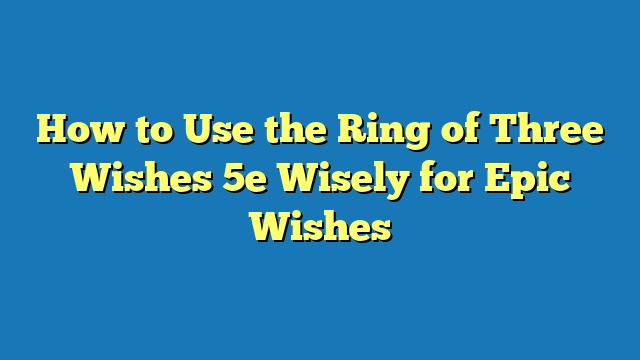In the realm of fantasy role-playing games, the “ring of three wishes 5e” is a legendary artifact that grants its possessor the ability to fulfill three extraordinary desires. Like the fabled genie’s lamp, it holds the potential to alter destinies and shape the course of history.
Throughout countless campaigns, the ring of three wishes 5e has been a coveted treasure, sought after by both heroes and villains alike. Its immense power has the potential to reshape civilizations, bestow untold riches, or grant dominion over magical realms. Legends speak of a great sorcerer who once used the ring to vanquish an ancient evil that threatened to destroy the world.
In this comprehensive guide, we will delve deeper into the origins, mechanics, and profound implications of the ring of three wishes 5e. We will explore its significance within the Dungeons & Dragons universe and discuss the strategies and considerations that come with wielding such extraordinary power.
Ring of Three Wishes 5e
The Ring of Three Wishes 5e is a legendary artifact in the Dungeons & Dragons universe, granting its possessor the ability to fulfill three extraordinary desires. Understanding its essential aspects is crucial for wielding its immense power effectively.
- Function: Grants three wishes.
- Rarity: Extremely rare.
- Attunement: Requires attunement by a spellcaster.
- Power Source: Divine or arcane.
- Alignment: Neutral.
- History: Lost to the annals of time.
- Legends: Tied to ancient heroes and cataclysmic events.
- Consequences: Wishes can have unforeseen repercussions.
- Safeguards: Limitations and restrictions may apply.
- Roleplaying: A catalyst for epic storylines and character development.
These aspects shape the Ring of Three Wishes 5e’s significance within the game. Its rarity and power make it a coveted treasure, while its alignment and history add depth to its lore. Understanding the potential consequences and safeguards associated with the ring allows players to make informed choices. Moreover, its roleplaying potential fosters engaging and memorable experiences for both players and Dungeon Masters.
Function
The “Function: Grants three wishes” is the defining characteristic of the Ring of Three Wishes 5e. It is the core ability that sets this artifact apart from all others in the Dungeons & Dragons universe. Without this function, the ring would be nothing more than a piece of ordinary jewelry.
The ability to grant three wishes is a power that is both immense and dangerous. It has the potential to reshape destinies, alter the course of history, and even destroy the world. As such, the ring is often sought after by both heroes and villains alike.
However, it is important to note that the Ring of Three Wishes 5e is not a genie’s lamp. The wishes it grants are not always straightforward or easy to fulfill. The ring has a mind of its own, and it often interprets wishes in unexpected ways.
This can lead to unforeseen consequences, both good and bad. For example, a wish for “unlimited wealth” could result in a flood of gold coins that crushes the recipient. A wish for “eternal life” could result in immortality without the ability to age or die, leading to a lonely and meaningless existence.
Therefore, it is important to use the Ring of Three Wishes 5e wisely. The wishes it grants can be powerful, but they can also be dangerous. It is important to think carefully about what you wish for, and to be prepared for the consequences.
Rarity
The “Rarity: Extremely rare.” aspect of the Ring of Three Wishes 5e is a critical component that significantly impacts its significance and gameplay dynamics within the Dungeons & Dragons universe.
The extreme rarity of the ring is primarily attributed to its immense power and the potential it holds to alter the course of events. As an artifact capable of granting three wishes, its presence in the game world is carefully controlled to maintain balance and prevent its misuse.
Real-life examples of “Rarity: Extremely rare.” within the context of the Ring of Three Wishes 5e can be observed in various forms. For instance, in official Dungeons & Dragons campaigns and modules, the ring is often hidden within treacherous dungeons, guarded by powerful creatures, or concealed in ancient ruins, making it a challenging and rewarding treasure to acquire.
Understanding the practical implications of the ring’s rarity is essential for both players and Dungeon Masters. For players, it instills a sense of excitement and anticipation in the pursuit of this legendary artifact. Its rarity adds to the thrill of discovery and enhances the value of its possession.
For Dungeon Masters, the rarity of the Ring of Three Wishes 5e provides an opportunity to craft compelling storylines and encounters centered around its acquisition. Its presence can drive entire campaigns, as characters embark on epic quests and face formidable challenges to claim its power.
In summary, the “Rarity: Extremely rare.” aspect of the Ring of Three Wishes 5e is a crucial element that contributes to its mystique, gameplay significance, and storytelling potential within the Dungeons & Dragons universe.
Attunement
The “Attunement: Requires attunement by a spellcaster.” aspect of the Ring of Three Wishes 5e is a crucial requirement that establishes a symbiotic relationship between the artifact and its wielder. Attunement, in the context of Dungeons & Dragons, refers to a ritual that binds a character to a magical item, allowing them to access its full potential.
In the case of the Ring of Three Wishes 5e, the requirement for attunement by a spellcaster is a deliberate design choice that aligns with the ring’s inherent nature. The power to grant wishes is a potent and potentially dangerous ability, and the game’s mechanics reflect this by restricting the ring’s use to those who possess the necessary magical aptitude.
Real-life examples of “Attunement: Requires attunement by a spellcaster.” within the context of the Ring of Three Wishes 5e can be observed in official Dungeons & Dragons campaigns and modules. In these adventures, the ring is often found hidden within ancient ruins or guarded by powerful creatures, and only spellcasters who successfully attune to it can claim its power.
The practical significance of understanding the relationship between “Attunement: Requires attunement by a spellcaster.” and the Ring of Three Wishes 5e lies in its impact on gameplay and storytelling. By limiting the ring’s use to spellcasters, the game designers ensure that its immense power is not accessible to every character in the party, adding a layer of strategy and exclusivity to its acquisition and utilization.
Furthermore, the attunement requirement establishes a narrative connection between the ring and its wielder, enhancing the roleplaying experience. Spellcasters who attune to the ring may experience unique visions, dreams, or insights, deepening their connection to the artifact and its enigmatic origins.
In summary, the “Attunement: Requires attunement by a spellcaster.” aspect of the Ring of Three Wishes 5e is a critical component that adds depth to the artifact’s mechanics, gameplay, and storytelling potential within the Dungeons & Dragons universe.
Power Source
Within the realm of “ring of three wishes 5e,” understanding the “Power Source: Divine or arcane.” aspect is crucial for unraveling the artifact’s origins and limitations. Identifying whether the ring draws its potency from celestial deities or mystical energies shapes its lore and gameplay mechanics.
-
Celestial Origin
If the ring’s power stems from divine sources, it may bear the blessings or curses of gods, influencing its wishes and imposing moral dilemmas upon its possessor.
-
Arcane Legacy
Alternatively, the ring’s power could be rooted in ancient arcane forces, making it susceptible to manipulation by skilled spellcasters and potentially harboring unpredictable or chaotic effects.
-
Hybrid Nature
The ring might possess a hybrid nature, drawing upon both divine and arcane energies, creating a complex and potentially volatile power source that requires a delicate balance.
-
Ancient Enigma
In some tales, the ring’s power source remains shrouded in mystery, lost to the annals of time, making its origins and limitations a subject of speculation and legend.
Ultimately, the “Power Source: Divine or arcane.” aspect of “ring of three wishes 5e” adds depth to the artifact’s lore, influences its gameplay mechanics, and provides opportunities for creative storytelling and exploration in Dungeons & Dragons campaigns.
Alignment
Within the context of “ring of three wishes 5e,” the “Alignment: Neutral.” aspect plays a significant role in shaping the artifact’s behavior and interactions. Neutrality, in the realm of Dungeons & Dragons, represents a balance between the forces of good and evil, order and chaos.
-
Independence and Autonomy
The ring, being neutral, is not bound by moral constraints or ethical dilemmas. It operates without prejudice, granting wishes based solely on their wording and the wielder’s intent, regardless of their alignment.
-
Unpredictability and Ambiguity
The neutral alignment of the ring introduces an element of unpredictability into its effects. Wishes may be interpreted in unexpected ways, leading to unintended consequences or outcomes that defy conventional expectations.
-
Potential for Good or Evil
The ring’s neutrality allows it to be used for both benevolent and malevolent purposes. Its power can be harnessed to heal the sick, vanquish evil, or inflict harm upon others, depending on the wielder’s desires.
-
Balance and Equilibrium
The ring’s neutral alignment serves as a reminder of the delicate balance that exists between the forces of good and evil. It emphasizes the importance of moderation, caution, and thoughtful decision-making when wielding such immense power.
Overall, the “Alignment: Neutral.” aspect of “ring of three wishes 5e” adds depth and complexity to the artifact. It introduces elements of unpredictability, moral ambiguity, and the potential for both good and evil, making each wish a momentous decision with far-reaching consequences.
History
The “History: Lost to the annals of time.” aspect of the “ring of three wishes 5e” adds an air of mystery and intrigue to the artifact. Its origins, creators, and previous owners are shrouded in obscurity, leaving much to the imagination and speculation of players and Dungeon Masters alike.
-
Ancient Origins
The origins of the ring are lost to the mists of time, with no definitive accounts or records of its creation. Legends and rumors hint at its existence in ancient civilizations, where it may have been wielded by powerful rulers or legendary heroes.
-
Forgotten Creators
The identities of the ring’s creators remain unknown, adding to its enigmatic nature. Whether it was forged by divine beings, skilled artisans, or beings from other planes of existence is a subject of endless debate.
-
Vanished Owners
The ring’s previous owners are as elusive as its origins. Over the centuries, it is believed to have passed through the hands of countless individuals, each leaving their own mark on its history. However, their names and deeds have faded into obscurity.
-
Unrecorded Events
The lack of historical records surrounding the ring leaves many of its past exploits and adventures undocumented. Its role in shaping the course of history remains a mystery, with only fragments of its influence hinted at in ancient texts and forgotten legends.
The “History: Lost to the annals of time.” aspect of the “ring of three wishes 5e” serves to enhance its mystique and allows for countless possibilities in storytelling. Its enigmatic origins and unrecorded past provide a fertile ground for Dungeon Masters to craft compelling narratives and engage players in imaginative exploration.
Legends
The legends surrounding the “ring of three wishes 5e” are deeply intertwined with ancient heroes and cataclysmic events, shaping its lore and significance within the Dungeons & Dragons universe.
These legends often depict the ring as a pivotal artifact in pivotal battles, wielded by valiant heroes to vanquish evil forces or avert impending disasters. The ring’s potent abilities have played a crucial role in shaping the destinies of nations and the course of history itself.
Real-life examples of these legends can be found in official Dungeons & Dragons campaigns and modules. In the “Rise of Tiamat” adventure, the ring is said to have been used by the legendary hero Mordenkainen to seal away the ancient dragon goddess Tiamat, preventing her from unleashing chaos upon the world.
Understanding the connection between the “ring of three wishes 5e” and these legends is essential for players and Dungeon Masters alike. It enhances the roleplaying experience by providing a rich backstory and context for the artifact. Moreover, it allows for creative storytelling opportunities, as players can explore the impact of the ring on historical events and the motivations of the heroes who wielded it.
Consequences
The “Consequences: Wishes can have unforeseen repercussions.” aspect of the “ring of three wishes 5e” is a critical component that adds depth and complexity to the artifact. It acknowledges the potential for unintended consequences when wielding such immense power.
Real-life examples of “Consequences: Wishes can have unforeseen repercussions.” within “ring of three wishes 5e” can be observed in various tales and legends. In the classic fairy tale “The Monkey’s Paw,” a seemingly benevolent wish to improve one’s life leads to a series of tragic events, ultimately resulting in the protagonist’s demise. Similarly, in the Dungeons & Dragons adventure “Curse of Strahd,” a wish to defeat a powerful vampire inadvertently empowers the villain, leading to dire consequences for the party.
Understanding the connection between “Consequences: Wishes can have unforeseen repercussions.” and “ring of three wishes 5e” is essential for players and Dungeon Masters alike. It encourages thoughtful consideration and roleplaying when making wishes, as even the most well-intentioned desires can have unintended outcomes. This adds a layer of suspense and moral ambiguity to the game, as players navigate the potential risks and rewards of using the ring’s power.
In conclusion, the “Consequences: Wishes can have unforeseen repercussions.” aspect of the “ring of three wishes 5e” serves as a cautionary reminder of the responsibility that comes with wielding great power. It emphasizes the importance of careful planning, ethical decision-making, and accepting the potential consequences of one’s actions.
Safeguards
The “Safeguards: Limitations and restrictions may apply.” aspect of the “ring of three wishes 5e” is a critical component that adds balance and depth to the artifact. It acknowledges that the ring’s immense power is not without its limitations and boundaries.
Real-life examples of “Safeguards: Limitations and restrictions may apply.” within “ring of three wishes 5e” can be observed in various tales and legends. In the classic fairy tale “Aladdin,” the genie’s powers are limited by three specific rules, including the inability to kill, bring people back from the dead, or make someone fall in love. Similarly, in the Dungeons & Dragons adventure “Out of the Abyss,” the “Deck of Many Things” is a powerful artifact that comes with a set of potential drawbacks and consequences for its users.
Understanding the connection between “Safeguards: Limitations and restrictions may apply.” and “ring of three wishes 5e” is essential for players and Dungeon Masters alike. It encourages careful consideration and roleplaying when making wishes, as the ring’s power is not limitless. This adds a layer of strategy and decision-making to the game, as players must weigh the potential benefits of a wish against the possible drawbacks or limitations.
In summary, the “Safeguards: Limitations and restrictions may apply.” aspect of the “ring of three wishes 5e” serves as a crucial element that enhances the artifact’s gameplay mechanics, storytelling potential, and overall balance within the Dungeons & Dragons universe.
Roleplaying
The dynamic between “Roleplaying: A catalyst for epic storylines and character development.” and “ring of three wishes 5e” is a symbiotic one. The ring’s immense power and potential for wish-fulfillment provide an unparalleled canvas for roleplaying, while the act of roleplaying breathes life into the artifact, giving it purpose and meaning beyond its mechanical capabilities.
Real-life examples of “Roleplaying: A catalyst for epic storylines and character development.” within “ring of three wishes 5e” abound. In the classic Dungeons & Dragons campaign “Curse of Strahd,” the players’ discovery of the ring sets them on a perilous quest to overthrow the titular vampire lord. Through roleplaying, the players explore their characters’ motivations, fears, and desires, making choices that shape the narrative and ultimately determine the fate of the realm.
Understanding this connection empowers players and Dungeon Masters alike. It encourages creative storytelling, imaginative problem-solving, and immersive roleplaying experiences. Players are no longer limited by the constraints of their character sheets but can delve into the depths of their characters’ personalities, motivations, and aspirations.
In conclusion, “Roleplaying: A catalyst for epic storylines and character development.” is a critical component of “ring of three wishes 5e.” It elevates the artifact beyond a mere mechanical device, transforming it into a catalyst for unforgettable adventures, meaningful character growth, and lasting memories.
Frequently Asked Questions About the Ring of Three Wishes 5e
This section aims to address some of the most frequently asked questions regarding the Ring of Three Wishes 5e, providing clear and concise answers to enhance understanding and gameplay.
Question 1: Can the Ring of Three Wishes 5e grant any wish?
The Ring of Three Wishes 5e can grant any wish, but it is crucial to word the wish carefully, as the ring interprets wishes literally. Unclear or ambiguous wishes may lead to unintended consequences.
Question 2: Are there any limitations to the Ring of Three Wishes 5e’s power?
The Ring of Three Wishes 5e has certain limitations. It cannot grant wishes that would fundamentally alter the nature of reality, resurrect the dead, or create more wishes. Additionally, the ring’s power is limited by the user’s own desires and beliefs.
Question 3: What are the potential consequences of using the Ring of Three Wishes 5e?
Using the Ring of Three Wishes 5e can have unforeseen consequences. Wishes may have unintended effects, or they may come at a great personal cost. The ring’s power is not without its risks, and it should be used wisely.
Question 4: How can I prevent the Ring of Three Wishes 5e from falling into the wrong hands?
The Ring of Three Wishes 5e should be kept secret and protected from those who would misuse its power. It is essential to be cautious and discerning when deciding who to trust with the ring’s knowledge.
Question 5: What role does the Ring of Three Wishes 5e play in character development?
The Ring of Three Wishes 5e can be a powerful tool for character development. It forces characters to confront their desires, fears, and beliefs. Through the choices they make regarding their wishes, characters can grow and evolve.
Question 6: How can I incorporate the Ring of Three Wishes 5e into my Dungeons & Dragons campaign?
The Ring of Three Wishes 5e can be incorporated into a Dungeons & Dragons campaign in various ways. It can serve as a major plot device, a reward for completing a quest, or a source of conflict between characters. Its presence can add depth and excitement to any campaign.
In summary, the Ring of Three Wishes 5e is a powerful and versatile artifact that can enhance gameplay and storytelling in Dungeons & Dragons. By understanding its mechanics, limitations, and potential consequences, players and Dungeon Masters can harness its power responsibly, creating memorable and engaging experiences.
As we delve deeper into the lore and mechanics of the Ring of Three Wishes 5e, we will explore additional strategies, tips, and considerations for incorporating this legendary artifact into your next Dungeons & Dragons adventure.
Tips for Using the Ring of Three Wishes 5e Effectively
The Ring of Three Wishes 5e is a powerful artifact that can greatly impact your Dungeons & Dragons campaign. Here are five tips to help you use it effectively:
Tip 1: Consider the consequences. Before making a wish, take time to think about the potential consequences. Wishes can have unforeseen effects, and it’s important to be prepared for both the good and the bad.
Tip 2: Be specific. When making a wish, be as specific as possible. The more specific you are, the less likely your wish is to be misinterpreted.
Tip 3: Don’t wish for more wishes. The Ring of Three Wishes 5e cannot grant wishes for more wishes. This is a common trap that many people fall into, so be sure to avoid it.
Tip 4: Be careful who you trust. The Ring of Three Wishes 5e is a powerful artifact, and it’s important to be careful who you trust with it. Not everyone will have your best interests at heart.
Tip 5: Use the ring wisely. The Ring of Three Wishes 5e is a powerful tool, but it’s important to use it wisely. Don’t make wishes that you don’t really need or that could have negative consequences.
By following these tips, you can use the Ring of Three Wishes 5e to its full potential and avoid any unintended consequences.
In the next section, we’ll discuss some of the ethical considerations that come with using the Ring of Three Wishes 5e. This is an important topic to consider, as the ring’s power can be used for both good and evil.
Conclusion
The Ring of Three Wishes 5e is a powerful artifact with the potential to grant its possessor’s deepest desires. However, it is important to use the ring wisely, as wishes can have unforeseen consequences. The ring’s power can be used for good or evil, so it is important to consider the ethical implications of using it.
Some key points to remember about the Ring of Three Wishes 5e include:
- The ring can grant any wish, but it is important to be specific when making a wish.
- The ring’s power is limited by the user’s own desires and beliefs.
- Using the ring can have unforeseen consequences, so it is important to consider the potential risks before making a wish.
The Ring of Three Wishes 5e is a powerful tool that can be used to achieve great things. However, it is important to use the ring responsibly and to consider the potential consequences of using it.









Tips for Using "Template by Kevin Crafts" Comments for Meaningful Online Discussions